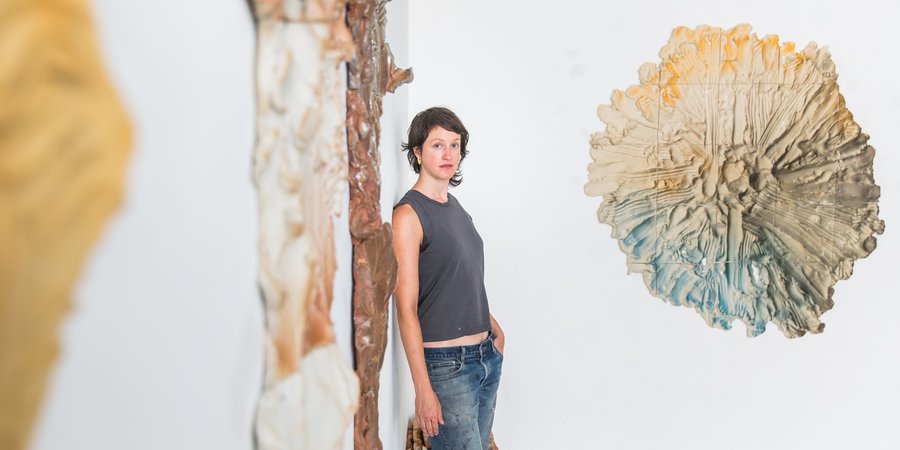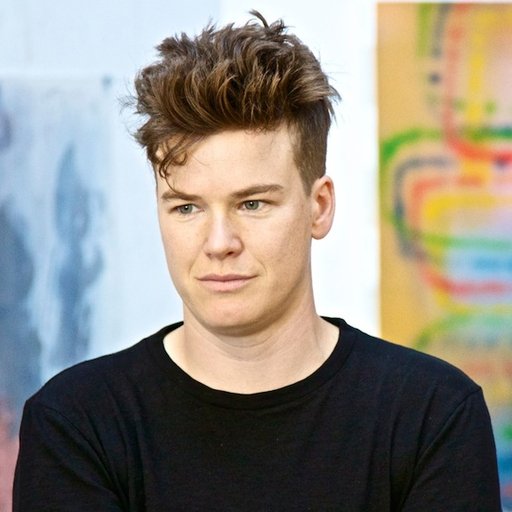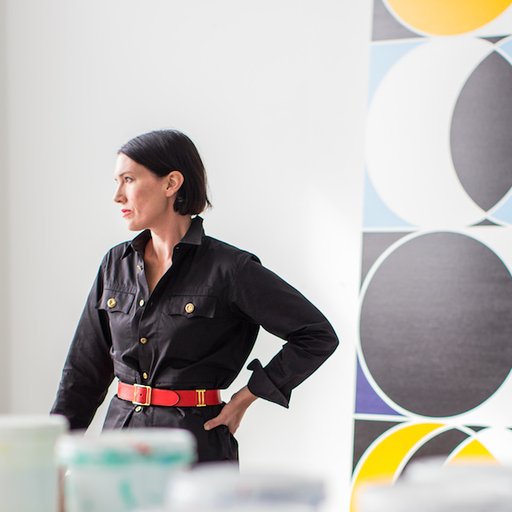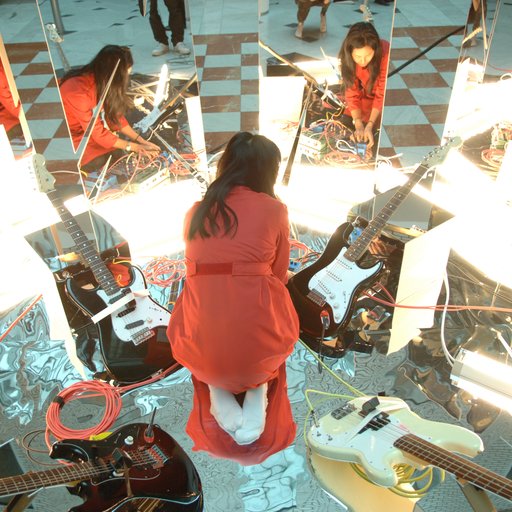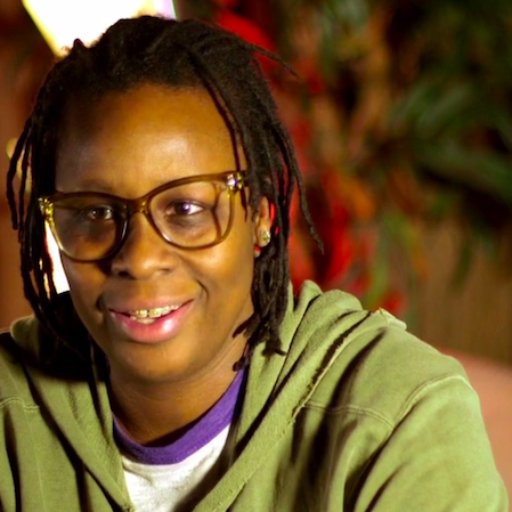Operating at the nexus where ceramics and conceptual art meet, Brie Ruais makes performative, physically taxing sculptures that arise as much from language as they do from clay. The titles of her works, like Push Up, 132 lbs, Stationary Forward Spread (Salmon) 132 lbs, Spreading Out From Center, 132 lbs., often function as descriptions of the works themselves: the weight of the sculptures matches the artist’s own, and the simple instructions reflect the bodily action through which the piece comes into being. These are not simply process-based artworks, however—Ruais applies colors and glazes with an intuitive eye, drawing inspiration from the natural landscape as well as the palettes of Abstract Expressionists like Lee Krasner.
Ruais is part of a generation of younger artists who have taken up ceramics with varied and often wonderful results. Her work has been featured in a number of solo shows in hip galleries around the world, including Mesler/Feuer in New York, Lefebvre & Fils in Paris, and Cooper Cole in Toronto, with a bevy of rave reviews to match. Artspace’sDylan Kerr met with the artist in her Sunset Park studio to discuss the sensuality of her sculpture, her favorite verbs, and why ceramics are making a comeback in contemporary art.
All photographs are studio shots of works in various stages of completion, taken by Scott Rudd in August 2015.
How did you first get started working with ceramics?
When I started making these works, my only experience with ceramics had been as a teenager in clay classes at the community center [where she grew up in Southern California], making incense holders and things like that. For years I was interested in materials that came from the world of craft, and by the time I applied to grad school I was working with a lot of found materials and organic objects. That kind of fell away once I started studying with my professors.
My engagement with clay started with really wanting to have a confrontation with the material. I wanted something that could capture a physical expression while at the same time posing its own set of questions and challenges just through the nature of the weight of the material and the difficulty of moving large quantities of it around. This whole world developed from the specificity of the process.

Articles and essays about your work love lists of verbs: you knead, push, transform, ram, impose, bully, abuse, and stomp your clay, among many other supposed actions. What verbs do you think about when working with clay?
The work actually starts with language. I think a lot about the things that we say about our existence and how we talk about being in the world. I want my work to be about reaching out or spreading out or pushing ahead—those are challenges that I face in my lived experience. I take that language and physically translate it with the work. A lot of the pieces are named as such: Spreading Out, Pushing Ahead, et cetera.
The first large-scale ceramic piece that I made was called The Big Push. That was while I was in grad school, and that was how things were feeling. It was a big push to find your vision, to find your voice, to make work that’s significant to other people and can be felt and speak to a shared experience. That’s where the scores to my work start, with this kind of language.
I'm making a piece called Spreading Out From Center now, where I start with my body weight in clay and then get on top of that mound of clay and spread it out radially around me. The reach of my body and the impressions of me moving around it—and my knee impressions, which remain in the center—are the physical embodiment of that idea of spreading out.
It’s interesting that you call these sets of written instructions for your works “scores.” There are a lot of entry points to talking about this idea: the history of conceptual art, Sol LeWitt and company, programming languages, magic, and obviously music and choreography. What I’m really curious about, though, is how the potential for failure is literally written into the work—you can fail to follow the instructions, or, once followed, the piece can fail to hold up either physically or aesthetically. How do you think about failure in your work?
I don't really think about it in terms of failure. For me, the instructions are a way of creating a situation where I’m freed up from making decisions, because they’ve been made beforehand. I’m allowed to put whatever energy is coming out of the experience of performing this task directly into the piece.
Sometimes, I’m not happy with it formally. It’s weird to have to make those decisions, because if it was a purely conceptual work of art then it wouldn’t matter what it looked like—it would just be about performing a certain kind of task. There are ways that my pieces can fail, though, in terms of not correctly capturing the energy.
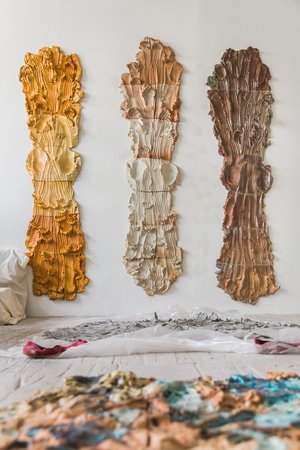
How do you make decisions about colors and glazes in your works? They don’t seem to have the process-based qualities of the clay itself, and they’re certainly not incidental in the finished piece.
For me, the piece is the most true to itself the moment after I make it. It’s still wet, it still has its malleability—it’s still alive. Once it starts to dry out, it starts to die. I’m constantly trying to figure out what it wants on its surface, because once it’s fired and dried and dead it becomes a document. I come to make decisions about the surface and color application as a way of injecting life back into it.
There is a part of my work where I use pigmented clay, so the color comes from the material itself. I’m still making decisions about what colors those are, but the color is not a surface application. The movement of the color records the gestures of making the work.
In most of my other work, the color is applied afterwards. Sometimes, I apply the color while the piece is still wet. Glazes are made up of a combination of chemicals, so for some pieces I separate those materials and use them in their raw state, splashing and sprinkling them on the surface. I’m interested in how these different applications lend another layer of energy to the piece—they take on really different personalities, depending on the approach to the surface.

The fact that the hunks of clay that you work with are often scaled to your own body, combined with the intensely physical sculpting process, lends these works a certain sensual quality. This is heightened in works like Two Ways Toward Center, where you and a friend pushed two body-weights of clay together to form a single mass. Do you see these works as sensual?
I think a lot about interdependency and the nature of our intersubjectivity—how we understand the world that we create together. I’ve thought about that a lot in terms of both friendships but also intimate partnerships. That’s where this idea of embodying the certain language that we use to describe relationships or ways of being comes from. The work sometimes acts as an illustration or expression of that.
In the work that I made with my then-partner, we were moving towards one another and pushing our body weights together. There was another piece that we made together where we were on opposite sides of the room and pushing the clay towards one another but missing each other and winding up in the place where the other started. I do explore those relationships, but I don’t think about it as a sensual approach.
I do think about the way that my body’s positions while making the work reflect or are somehow tapped into an inherited muscle memory. I’m often on my knees and spreading the clay forward, and I recognize that that’s maybe a prayer position, or a position that’s found in washing clothes or scrubbing the floor. They’re related to all different kinds of gestures that people make in labor and prayer, and maybe also in lovemaking.

Grounding the work even further in your body is your insistence on the importance of mass, working with hunks of clay scaled to your own body weight and highlighting that dimension in the title. Why focus on the weight of your sculptures?
It’s a way of directly addressing my occupation of space, how much space my physical body takes up. I suppose it’s not accurate in terms of weight—it should be more like volume, or something [laughs].
I think a lot about how art can be generous. Nothing about my process is concealed. You can see how everything is done. You can see how the clay is moved, how the tiles are cut, how they’re attached to the wall. I guess I feel like including that information is important. It’s a way of opening up.
Can you say any more about this idea of art being generous? Is it just a matter of a certain transparency in process?
No, it’s more than that. I could make the choice not to include the weight, but I feel like I would be withholding a crucial part of the work itself. Something that Agnes Martin said really struck me as true—she believed that her work achieved its importance only through being seen by others. I think that that’s really generous too, that she felt that it was activated by being seen. That’s kind of how I feel as a person in the world. We rely so much on other people reflecting ourselves back at us in order to understand both ourselves and the world around us. I think about it as an intersubjectivity that happens between the artist and the viewer.

For works that so clearly illustrate the human touch, it’s notable that something as supposedly “unnatural” as the grid still serves a central role in your work. Is this simply a practical answer to the question of how to get these things in the kiln, or is there more at play here?
It did start with a practical necessity, but it’s more now. The work could be cut up in a lot of different ways. That’s a part of the ceramic tradition that is super interesting to me. This older artist named Arnie Zimmerman who’s been working with ceramics forever once looked at my work and said to me, “Of course! Ceramicists have always had to deal with the question of how to get a piece from the floor to the wall.”
It’s always in tiles—you can see that through the use of tiling in architecture and design. I’m really interested in that lineage. The grid slows time down and makes you look. It addresses the labor of the process, that this is a piece that had to be broken down in order to move through time.

How much do you consider artistic tradition, both in the context of ceramics specifically and in contemporary art in general?
I didn’t know a lot about the history of ceramics when I started using clay, so I’ve only been researching it recently. I came to it through sculpture at a time when people like Nicole Cherubini, Jessica Jackson Hutchins, and Arlene Shechet were gaining some visibility. I saw their work as being more sculpture than ceramics, and I was super interested in how they were using the material.
Being from California, maybe I absorbed some of the California Clay Movement. It was huge in the ‘50s, and it really took clay from a place of craft to a place of sculpture. People like Peter Voulkos and John Mason were really pushing the capabilities of the material. I didn’t know about that when I started making the work, but knowing it now I can see where this comes from.

Your Affirmation Pots, those misshapen vessels adorned with cheekily positive statements like “nice try” and “bet you can,” seem like a real departure from the rest of your work. Where do they fit into all this?
That’s where the craft relationship comes in. I started making them when I was taking a ceramics class with JJ PEET at the Y. There are certain limitations when you’re taking a class like that—you have to pay for firing by the square inch and it’s kind of pricey, so I just ended up scaling down and figuring it out.
It was a time when I really needed to hear affirmations, and they really took on a life of their own. I guess it goes back to language. They talk about themselves, both to themselves and to the viewer at the same time. I use a lot of phrases that are sarcastic or ironic or a little bit playful.
How earnest are these affirmations?
They started out really earnest, but then I found the humor in them. Actually, I found the humor of me, a totally untrained person working with clay trying to make these vessels that ended up being really pathetic pots. They kind of internalized that amateur approach.
Your website has a few photographs on the front page, sometimes paired with your sculptures. How does photography figure into your work?
I take a lot of photos of the natural landscape, so I do think about the relationship that clay has to the earth, but I also think about my body occupies space. When it’s in the natural landscape, you have a really different perception and experience of how much space you take up. I also take a lot of inspiration from the colors, textures, and surfaces of nature.

If the art fairs of the past few years are anything to go by, ceramic sculpture seems to be having a real moment. Why do you think that might be?
It’s interesting, because it’s not only in the art world—it’s happening in the design world too, and even platforms like Etsy are acquiring a big market for it. I think people are interested in the hand and the handmade again, because technology is pushing us further and further away from that.
As an artist who works with ceramics, what do you make of this development? Are you worried about the field getting crowded?
No, not really. I don’t really think about it as ceramics as such. I see it more as sculptors finding a material that speaks to them. It’s not a new material, but it is new to a lot of fine artists.











